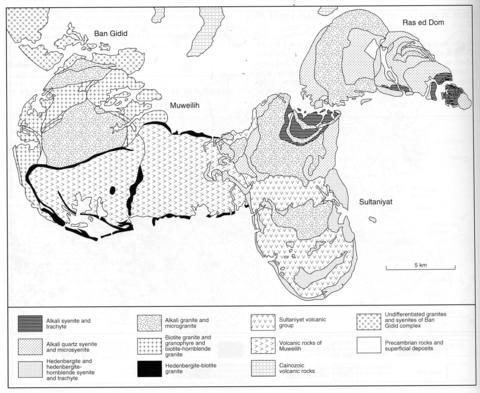stripes
Cutting the Muweilih complex (No. 155-00-038) in the northwest and being transected by Ras Ed Dom (No. 155-00-040) in the northeast, Sultaniyat is a complex of intrusive and extrusive rocks of 16x7 km emplaced in Precambrian gneisses with some sedimentary rocks. The earliest rocks of the complex are volcanics into which the intrusive rocks were emplaced. Curtis (1979) divided the volcanic rocks into two major groups the earliest of which, the Muweilih-Sultaniyat group, outcrops over much of the southern and central areas and in the west is in continuity with the Muweilih complex. It consists of agglomerate, breccia, rhyolitic tuff and ignimbrite and rare rhyolitic and mugearitic lavas. The second 'Southern and Central' group may reach 2000 m in thickness and is composed of similar rocks to the first group. Clasts in the coarser volcanic rocks are of trachyte and rhyolite. The ignimbrites contain abundant groundmass aegirine and sodic amphibole and phenocrysts of sanidine and quartz, and the same minerals are present in crystal-lithic tuffs. Twelve intrusive units were mapped by Curtis (1979), all being syenitic or granitic in composition. Four units are ring or boundary dykes, the rest irregular intrusions within the volcanic rocks. The Sultaniyat ring dyke is the outermost unit around much of the southern part of the complex having an overall length of some 18 km. The syenites and granites comprise alkali feldspar, variable quartz, a broad range of clinopyroxenes including ferroaugite, hedenbergite, aegirine-augite and aegirine, with the more alkaline pyroxene in the granites, amphiboles, including ferro-richterite, riebeckite and arfvedsonite, again with the more alkaline varieties occurring in quartz syenites and granites. Dykes and cone-sheets, which are mostly concentric, are abundant all around the complex, particularly in the country rocks to the northeast, and also within the complex itself, notably in an east-west zone across the central area. Curtis (1979) demonstrates that they are concentric about focii in the northern and southern parts of the complex. The dykes are felsites and spherulitic rhyolites, the former with or without quartz and alkali feldspar phenocrysts, aegirine and/or sodic amphibole. Spherulites in the rhyolites vary between 0.5 mm and 4 cm in diameter, and exceptionally up to 10 cm, and are generally of sodic amphibole. Jebel Sufra and two nearby smaller hills lie to the south of Sultaniyat and consist of rhyolitic pyroclastic rocks and felsite; a swarm of felsite dykes are radial to this centre. Four plugs of basic rocks are located on the eastern side of Sultaniyat of which rocks from the nearest, Jebel Hawdat, are chemically basanites and trachybasalts. Curtis (1979) gives numerous analyses of rocks, including some trace element data, pyroxenes and amphiboles.
BARTH, H., BESANG, C., LENZ, H. and MEINHOLD, K.-D. 1983. Results of petrological investigations and Rb/Sr age determinations on the non-orogenic igneous ring-complexes in the Bayuda Desert, Sudan. Geologisches Jahrbuch, 51: 1-34.CURTIS, P.A. 1979. The geology of the Sultaniyat ring-complex, Bayuda Desert, Sudan. Ph.D. thesis. Portsmouth Polytechnic. 290 pp. (unpublished).

